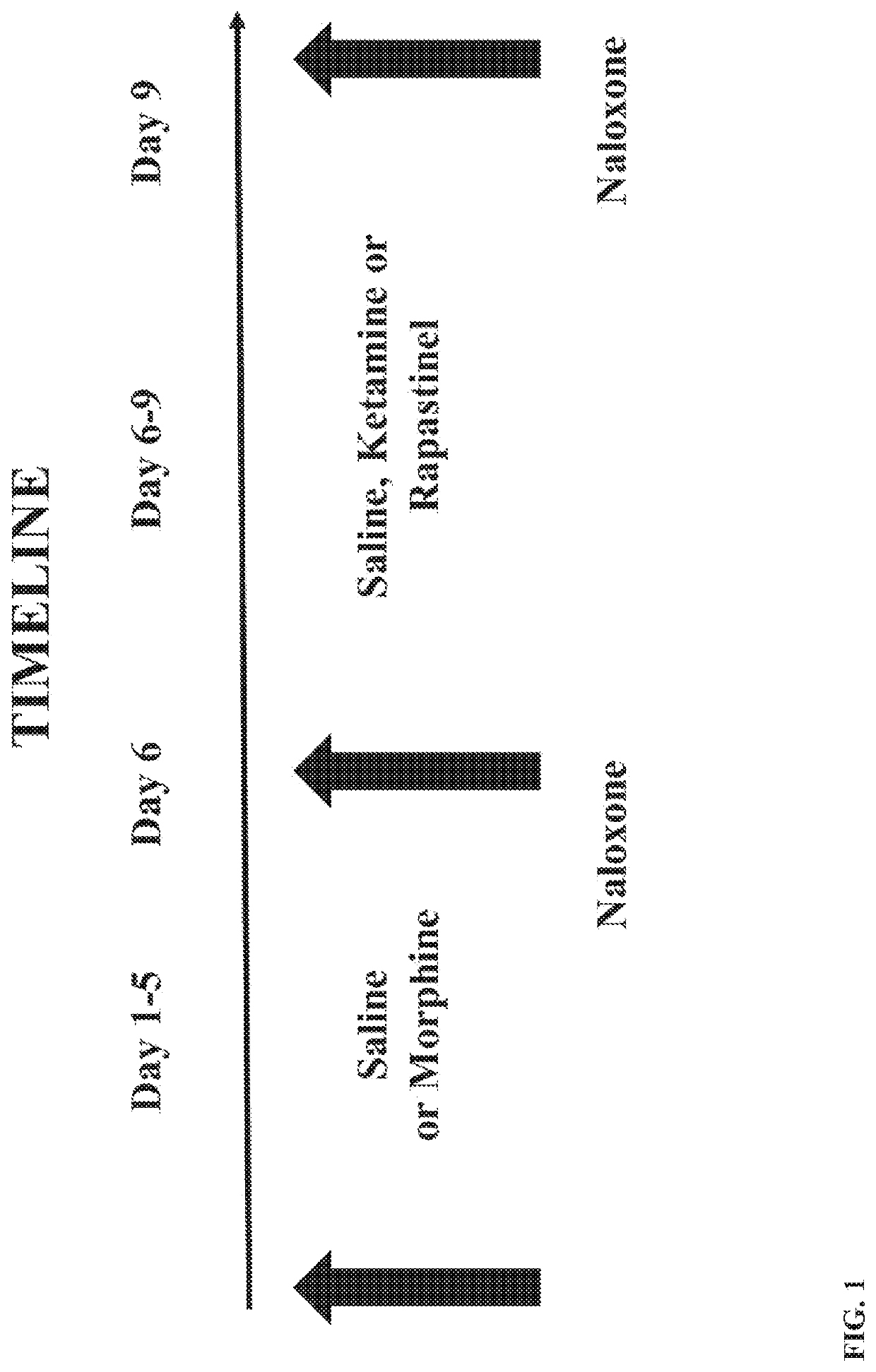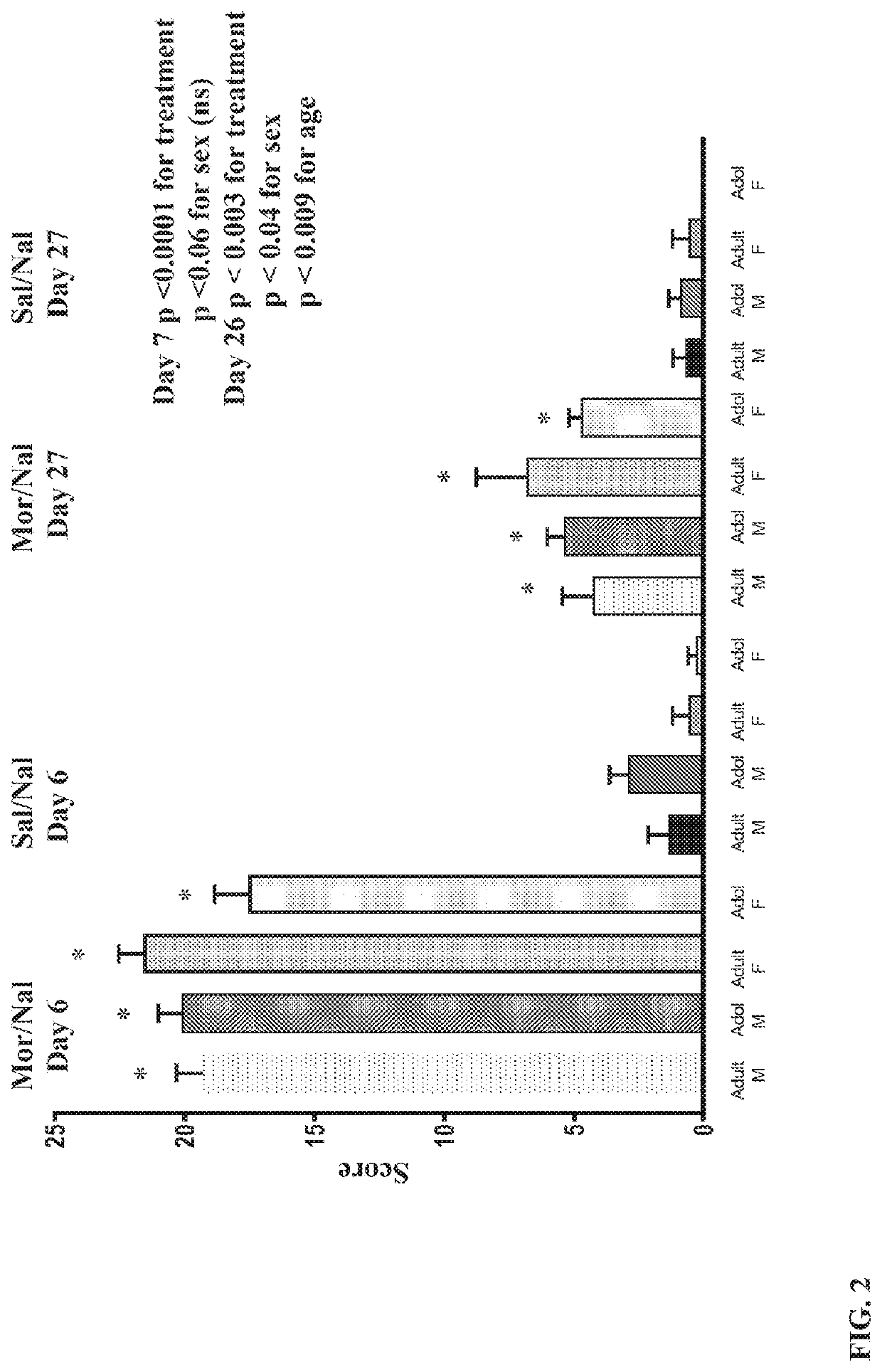Methods and compositions for the treatment of opioid dependence and for the treatment of pain
- Summary
- Abstract
- Description
- Claims
- Application Information
AI Technical Summary
Benefits of technology
Problems solved by technology
Method used
Image
Examples
example 1
l Significantly Enhances Recovery from Opioid Dependence
[0069]Male and female adolescent and adult Sprague-Dawley rats (PN 28-30 and PN 60-75) from Charles River Laboratories were treated with a 5-day, increasing dose morphine regimen (5 mg / kg bid, increasing 5 mg / kg / day to 25 mg / kg) to induce opioid dependency. Animals were group-housed in a 12 / 12 light / dark cycle with free access to water and standard lab chow. Agents were administered by intraperitoneal injection. In Study 1, animals received morphine (25 mg / kg) on day 6 followed 1 hour later by a naloxone challenge (1 mg / kg) and withdrawal behaviors were quantified as described by Gellert and Holtzman (J Pharmacol Exp Ther. 1978; 205(3):536-546). A second morphine / naloxone challenge was given 21 days later (study day 27). In Study 2 (see FIG. 1), male and female adolescent rats received the same morphine treatment, but on day 6 they received naloxone only (1 mg / kg) to precipitate withdrawal and withdrawal signs (wet dog shakes, ...
example 2
l Improves Withdrawal-Precipitated Hyperalgesia
[0073]Rats were treated and pain sensitivity was measured in accordance with the schematics presented in FIG. 6. There was no difference in hyperalgesia caused by morphine withdrawal before treatment; there was significant expression of naloxone-precipitated hyperalgesia in morphine dependent animals. See FIG. 7. However, morphine-dependent rats treated with rapastinel trend towards a return to baseline (SS) hyperalgesia scores. See FIG. 8. Thus, rapastinel blunts hyperalgesia but does not alter baseline (SS) response, and is effective in the treatment of pain.
Example 3: Rapastinel and the GluR1 Receptor
[0074]The medial prefrontal cortex (mPFC) Brain Region is responsible for decision making in the context of reward (opioids) and penalty (withdrawal). Rats were treated with morphine in accordance with the methods of Example 1. The mPFC was dissected from rats at end of treatment and GluR1 expression levels were measured with a Western B...
example 4
o Morphine CPP
[0076]CPP and extinction were conducted in adult male and female rats with a biased CPP procedure adapted from Mueller et al. (Mueller et al., Behavior. Brain Res 136: 389-397(2002)). CPP is conducted in a two-sided chamber. Side 1 had white walls and plexiglass flooring, and Side 2 had black walls and plastic mesh flooring (preferred side).
[0077]Rats went through a conditioned place preference procedure involving daily pairing with saline and morphine (2.5 mg / kg) on opposite sides of the CPP apparatus for 4 days. On habituation day (day 1), animals were allowed to explore the whole apparatus for 30 minutes. On days 2-4, rats were restricted to Side 1 for morphine (2.5 mg / kg sc) and Side 2 for saline (alternated am and pm daily). On day 5 they received a test of conditioning in which they were allowed to explore the whole apparatus. For the next 4 days (days 6-9) they received daily saline or rapastinel (5 mg / kg) 30 minutes before twice daily extinction trials in which...
PUM
 Login to View More
Login to View More Abstract
Description
Claims
Application Information
 Login to View More
Login to View More - R&D
- Intellectual Property
- Life Sciences
- Materials
- Tech Scout
- Unparalleled Data Quality
- Higher Quality Content
- 60% Fewer Hallucinations
Browse by: Latest US Patents, China's latest patents, Technical Efficacy Thesaurus, Application Domain, Technology Topic, Popular Technical Reports.
© 2025 PatSnap. All rights reserved.Legal|Privacy policy|Modern Slavery Act Transparency Statement|Sitemap|About US| Contact US: help@patsnap.com



